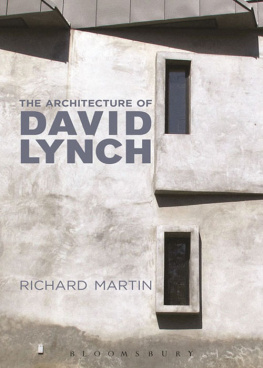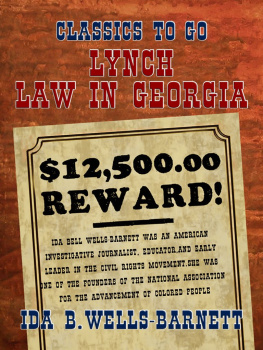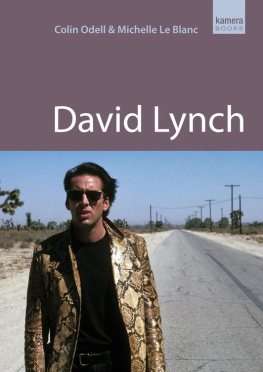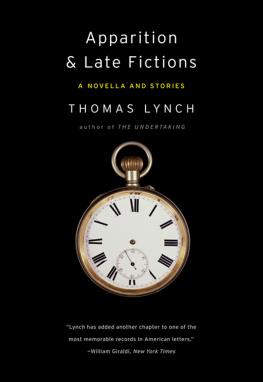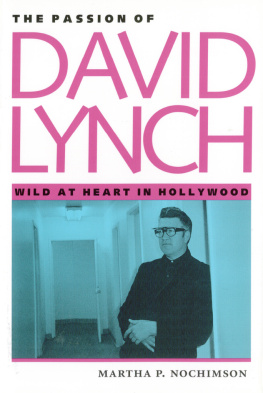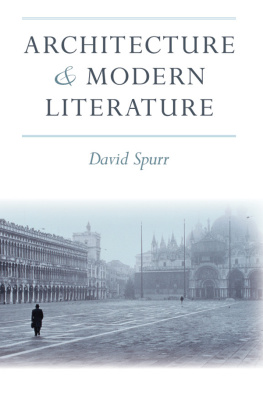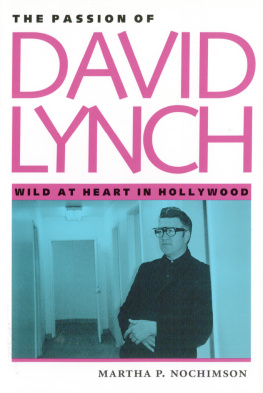Martin - The Architecture of David Lynch
Here you can read online Martin - The Architecture of David Lynch full text of the book (entire story) in english for free. Download pdf and epub, get meaning, cover and reviews about this ebook. year: 2015, publisher: Bloomsbury UK, genre: Romance novel. Description of the work, (preface) as well as reviews are available. Best literature library LitArk.com created for fans of good reading and offers a wide selection of genres:
Romance novel
Science fiction
Adventure
Detective
Science
History
Home and family
Prose
Art
Politics
Computer
Non-fiction
Religion
Business
Children
Humor
Choose a favorite category and find really read worthwhile books. Enjoy immersion in the world of imagination, feel the emotions of the characters or learn something new for yourself, make an fascinating discovery.
- Book:The Architecture of David Lynch
- Author:
- Publisher:Bloomsbury UK
- Genre:
- Year:2015
- Rating:4 / 5
- Favourites:Add to favourites
- Your mark:
- 80
- 1
- 2
- 3
- 4
- 5
The Architecture of David Lynch: summary, description and annotation
We offer to read an annotation, description, summary or preface (depends on what the author of the book "The Architecture of David Lynch" wrote himself). If you haven't found the necessary information about the book — write in the comments, we will try to find it.
The Architecture of David Lynch — read online for free the complete book (whole text) full work
Below is the text of the book, divided by pages. System saving the place of the last page read, allows you to conveniently read the book "The Architecture of David Lynch" online for free, without having to search again every time where you left off. Put a bookmark, and you can go to the page where you finished reading at any time.
Font size:
Interval:
Bookmark:
To Alice Honor Gavin, and to Seba Davies

THREE JOURNEYS
d , on a gray winters day
In December 2009, Frank Gehry unveiled designs for a new cultural center in the city of d a multi-purpose facility including Polands largest movie theater (Plate 1). Set alongside a rusting power station, Gehrys cluster of spectacular interlocking forms in many ways exemplifies contemporary architectural trends: a decaying industrial landscape is transformed thanks to a global starchitect. Yet, one feature of the indicative images caught my attention: the projection onto the centers glass faade of a scene from David Lynchs film Inland Empire (2006). Walking around the site of Gehrys plans, I tried to imagine the connections between a Polish regeneration project and one of Hollywoods most perplexing film-makers. In what sense, I asked myself, do Gehrys designs reflect the architecture of David Lynch?
Paris, in the spring
Designed by Jean Nouvel and completed in 1994, the Fondation Cartier in Paris is a building with cinematic ambitions. It features a series of enormous screensan elongated faade and two glass frames positioned between the building and the Boulevard Raspailwhich manipulate light and perception. The intention, Nouvel claims, is to blend the real image and the virtual image.same space, the furnishings finished with a scribbled texture (Plate 3). Here, the real and the represented were again in conversation. Walking through this eerie stage set, inside a building self-consciously exploring perception, I found myself wondering: is this the architecture of David Lynch?
Los Angeles, in the sunshine
I cant drive, so getting around Los Angeles was a struggle. One day, in the summer of 2009, I hired a local woman named Karen to drive me to various locations in the city. Our first destination was Senalda Road, tucked beneath Mulholland Drive in the quiet curves of the Hollywood Hills. Surrounded by rich vegetation, the street contains three stark concrete structures, built in the late 1950s and early 1960s, and now owned by David Lynch. As we drove along Senalda Road, I asked Karen to slow down. The first building we met, an image of which adorns the cover of this book, was an unnerving distortion of domestic modernism, with a mottled faade broken only briefly by narrow glass slots and a larger window wrapping around one corner. It was instantly recognizable, despite slight remodeling, as the setting of Lynchs Lost Highway (1997), and it now contains the directors editing suite and a screening room. As we drove by, I took as many photos as possible, trying to recreate the perspective Lynchs camera held on the building. What was I doing with this familiar sight (or site)? Was I, in Nouvels terms, seeing the building or the image of the building? Was I projecting, like Gehry, Lynchs own images onto the exterior of the house?
The next building on the street, a less distinguished structure with heavy discoloring on its once-white walls, serves as offices for Lynchs company, Asymmetrical Productions. As we approached the third building, Karen suddenly shouted, Hes there! Hes on the street! Sure enough, in front of his home, the Beverly Johnson House (Plate 4)a hulking form with Mayan touches and a pinkish hue, designed by Lloyd Wright (son of Frank)stood David Lynch. He was impeccably dressed in a crisp white shirt, buttoned to the collar. He looked just like David Lynch. He was talking with a group of people spread across the street. As we stared at them, they began to look at us. Given our slow pace and my conspicuous camera, our presence started to seem rather creepy. Excruciatingly, our car parted the group. I sat embarrassed in the passenger seat as Lynch stared into the vehicle. We parked around the corner and returned to the house on foot, expecting (dreading) a face-to-face conversation. But the street was now empty. A lone man surveyed us from the balcony of Asymmetrical Productions, and his look was enough to hurry us along. I took a few more photos and we left, sharply. Back in the car, I thought: was that the architecture of David Lynch?
MAPPING THE LOST HIGHWAY
Architecture is the first manifestation of man creating his own universe.
LE CORBUSIER,TOWARDS A NEW ARCHITECTURE(1923)
All my movies are about strange worlds that you cant go into unless you build them and film them.
DAVID LYNCH (1990)
This book explores the relationship between architecture and David Lynchs films. In a career spanning six decades, Lynch has exhibited an acute spatial awareness. He has traveled across the United States, taking us from apartments immersed in industrial noise to hill-top mansions lit up by the Californian sun. He has charted the woods and waterfalls of the Pacific Northwest, decrepit towns in the Deep South, and green fields and grain elevators in Iowa and Wisconsin. He has plotted small-town family homes, grubby motels and empty highways. He has crossed continents to record London and d . And, though neither he nor we may care to be reminded of it, he has flown us to the planet Dune.
According to Rem Koolhaas, the most important thing about architecture is arriving in new worlds, rather than returning to old ones.films by examining the architecture we see within them? Second, what can be learned about architecture, especially the spatial developments of post-war America, by examining Lynchs films?
Many filmmakers, Hitchcock once complained, forget how important geography is to a story. No Lynch film is complete without an ominous close-up of a mysterious numbered door, and other specific architectural forms, brimming with intensity, recur throughout his work: corridors, staircases, rhythmic machinery and red curtains. His camera frequently pauses on vacant spaces, encouraging us to comprehend their meaning. Elsewhere, it leads us disturbingly around corners. Occasionally, we are thrust, without warning, into dark openings. On entering a room, the layout can feel Lynchian at once: the walls faded, the furniture too perfectly arranged, the entire atmosphere askew. Our experience of the space may be radically changed by a shift in lighting or sound. The materials of this universe are vital, too. Velvet drapes, spinning vinyl, lush lawns and firing matches are instilled with cosmic implications. His architecture is tactile and sensuous, filled with textures and a striking attention to surfaces. While watching Lynchs films, spatial awareness is both demanded and undermined. His worlds combine murky geography with absolute precision. Lynchs films are littered with sign-posts, informing the audience we have entered Big Tuna, Texas or are traveling along Sunset Boulevard in Los Angeles. Characters, very deliberately, intone addresses and street names as if they hold magical significance. We are repeatedly told exactly where we are. Equally, we often feel without any bearings at all. This, perhaps, is what it means to map a lost highway.
Over the course of his career, Lynch has shot on location in busy cities and within deserted forests, as well as in studio environments. His films demonstrate an exceptional ability to uncover places with complex pasts, enabling our own excursions into wide-ranging territory. This book will discuss the decline of the American downtown, will question how architecture shapes social relations, and will reconsider the translation of European modernism across the Atlantic. Assessed as a whole, Lynchs career constitutes an idiosyncratic history of architecture and design. Yet, how does this process of un-learning take place? What kinds of architectural thinking does Lynchs work affirm or disavow? Or, if we are not seeking how to get itwhich, in this case, might mean attempting to solve Lynchs puzzling films, a common desire they provokethen what else might we discover in watching them?
Next pageFont size:
Interval:
Bookmark:
Similar books «The Architecture of David Lynch»
Look at similar books to The Architecture of David Lynch. We have selected literature similar in name and meaning in the hope of providing readers with more options to find new, interesting, not yet read works.
Discussion, reviews of the book The Architecture of David Lynch and just readers' own opinions. Leave your comments, write what you think about the work, its meaning or the main characters. Specify what exactly you liked and what you didn't like, and why you think so.

